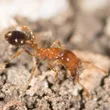
Harmful Effects of Fire ant
A species of Fire ants, Also known as Tropical fire ants, Ginger ants
Fire ant can pose health risks through stings, injecting neurotoxin that causes pain, swelling, and redness. Repeated stings may lead to necrosis or anaphylaxis in sensitive individuals. Bites cause mild discomfort but are usually followed by a venomous sting. Transmission occurs via direct contact when fire ant feels threatened. Most reactions are mild but can escalate in severity.
Is the Fire ant poisonous?
Does the Fire ant bite humans or animals?
More about insect bites and stings (Symptoms, Prevention, Treatment, etc)
Does the Fire ant sting humans?
More about insect bites and stings (Symptoms, Prevention, Treatment, etc)
Harmful Facts About Fire ant
What Type of Pest Is Fire ant?









AI entomologist in your pocket
Scan QR code to download

